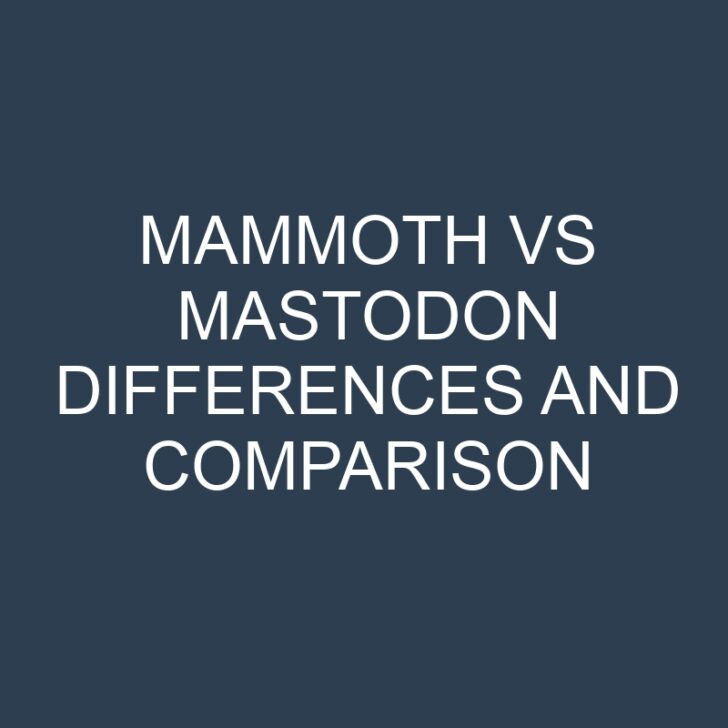
Post Contents
Overview: Mammoth vs Mastodon
Mammoths belong to the proboscideans order of the trucked mammals; they are species of extinct elephantid genus Mammuthus. Mammoths were enormous; they had long-curved tusks, furry long hairs. Mastodons also belong to proboscideans order and are species of extinct genus Mammut’s. Mastodons were similar in size to elephants but had large straight tusks. In comparison to mastodons, mammoths were quite large and heavy; they briefly coexisted during ice-age. If these prehistoric animals interest you, then you might have got a thought about who would have won if they confronted each other?? To determine the winner let’s know about them.
The Era of existence:
Mammoths existed from Pliocene to Holocene age and got extinct about 10,000 years ago. Mastodons came into existence before the mammoths i.e. they were in existence even before than mammoths; however, they coexisted for a short period. Mastodons lived from the late Miocene era (5.3 million years ago) to the late Pleistocene era. The reason for the extinction of mammoths and mastodons is still unknown. Some scientist believes mammoths got extinct due to some genetic disease. There DNA got mutated which resulted in the loss of sense of smell, their woolly fur became ‘silky, shiny’ etc.
Physical Traits:
Both mammoths and mastodons had a muscular body, trunk, tusks, tail and were quadrupedal i.e. they walked on four legs. Mammoths were bigger and heavier than mastodons; they weighed about 5.4-13 tons, an adult mammoth had a height of 2.5-4 metres till the shoulder. Mastodons were 2.3-2.8 metres in height, weighed between 5 to 8 tons.
Mammoths had fur (or woolly fur), short tailed whereas mastodons had long, brown coloured shaggy fur and hairy tail. The head of the mammoth was heavy, peaked and had large ears whereas the mastodons had a low, long skull and small ears.
The most distinguishing feature between them is their tusks. Mammoths had long and curved tusks whereas the tusks of mastodons were long and straight. Mammoths were grazers so they had flat-surfaced molar for chewing grass whereas the molars of mastodons were like pointed cones as they were wood browsers. In their lifetime mammoths had six sets of the enabled plate as teeth each got replaced after some time whereas mastodons didn’t replace their teeth as they only had one set of teeth.
Habitat:
Mammoths lived in Africa, Europe and North America having periglacial landscape with rich grazing grounds and vegetation. The remains of mastodons were found in Africa, Europe, Asia and America which suggests they existed there. They were grazers as well as browsers and lived in forests.
Behavioural Traits:
Like modern-day elephants, mammoths and mastodons lived in a strict social order. Each herd had a female as a matriarch, females lived with their young one whereas the bull lived alone or in small groups with other males.
Combat: Dinosaur Battle: Who would win??
As Mammoths and Mastodons briefly coexisted, they might have had encountered each other. When it comes to size, Mammoths were humungous whereas mastodons were short sized. If one-on-one battle ever happened between these two, then Mammoth already had an advantage; apart from the size, Mammoth also had big curved tusks to warn other dinosaurs. If mastodon dared to attack mammoth; then mammoth would have won. As mammoths were large woolly dinosaurs, they could have bear the attack of mastodon and retaliated with extreme aggression. The only way left for mastodon to stay alive was to run away from Mammoth. Mastodon stands no chance to win against mammoth; hence, Mammoth is the winner of this prehistoric dinosaur battle.
Comparison Chart: Mammoth vs Mastodon
| Comparison Heads | Mammoth | Mastodon |
|---|---|---|
| Kingdom | Animalia | Animalia |
| Phylum | Chordata | Chordata |
| Class | Mammalia | Mammalia |
| Order | Proboscidea | Proboscidea |
| Family | Elephantidae | Mammutidae |
| Genus | Mammuthus, Brookes, 1828 | Mammut, Blumenbach, 1799 |
| Era of Existence | From Pliocene to Holocene | Between Late Miocene to Pleistocene |
| Found in | Africa, Asia, Europe, North America | Africa, Asia, Europe, North & South America |
| Habitat | Preglacial landscapes | Forest dwellers |
| Weight | 5.4-13 tons | 5-8 tons |
| Height | 8-12 feet | 7-8 feet |
| Head | High and peaked | Low and Long |
| Ears | Large | Small |
| Tail | Short with sparse hair | Long and hairy |
| Tusks | Long and curved | Long and Straight |
| Teeth | Ridged molars | Cusped Molars (pointed) |
| Diet | Grass, shrubs, leaves | Shrubs, twigs, grass, leaves |
